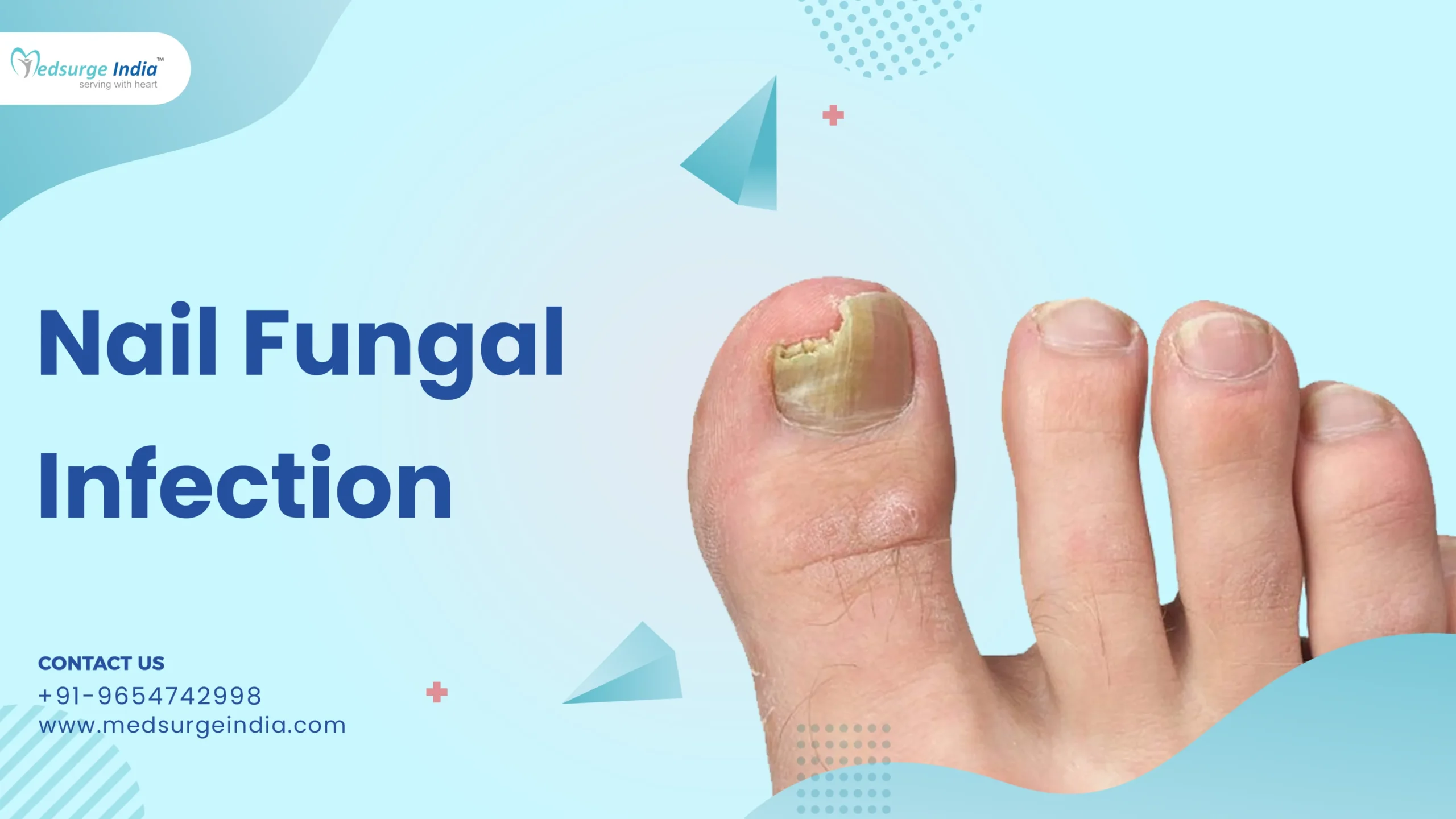
What You Need To Know About Nail Fungal Infection?
Fungal nail infection affects many persons at some time in their life span. Fungal nail infections occur when some fungus gains entrance into the nails. It is not life-threatening but often uncomfortable and sometimes hard to cure. The infection is chronic and the nail weakens, loses its normal color, becomes thicker, and grows abnormally.
Toenails are more commonly impacted than fingernails. The clinical term for a fungal nail infection is onychomycosis. Fungal infections have the potential to affect any area of the body. Fungi naturally coexist with various bacteria both on and within the body. However, an infection may occur when there is an overgrowth of fungi.
In this blog, we will present a comprehensive overview of nail fungal infections, including prevalent causes, symptoms, and available treatment options.
What is nail fungal infection?
Nail fungus represents a prevalent infection affecting the nails. It typically manifests as a white or yellow-brown spot located beneath the tip of either a fingernail or toenail. As the infection progresses, the nail may undergo discoloration, thickening, and crumbling at the edges. This condition can impact multiple nails simultaneously.
In cases where the infection is mild and not causing significant discomfort, treatment may not be necessary. However, if the nail fungus results in pain and leads to thickened nails, implementing self-care measures and utilizing medications may provide relief. It is important to note that even with successful treatment, nail fungus tends to recur.
Nail fungus is medically referred to as onychomycosis. When the fungus infects the spaces between the toes and the skin of the feet, it is identified as an athlete’s foot or tinea pedis.
What are the different types of nail fungal infections?
It is important to know that there are four major types of fungal nail infection. Each looks slightly different:
Distal or lateral subungual onychomycosis: This type is the most common one that is found widely in other classification models of economic activity. It originates from a group of fungi that is referred to as a dermatophyte. You may find it near the affected area like, you can get it in your fingernails or toenails. It originates at the nail base, at the proximal, subungual area of the nail, on the nail-bearing skin. This will appear as a yellowish-colored region that stretches from the sides of the nail up to the middle part and regions that are loose from the nail matrix.
White superficial onychomycosis: This is not very frequent and only affects the outer part of the nails, especially the toenails. It begins with pinpoint lesions that are powdery and end up making the nails break into powder.
Proximal subungual onychomycosis: This features first as whitish discoloration in the region of the nail matrix at the base of the nail plate. It also moves outward with it as the finger or toenail progresses. It is rare and occurs commonly in persons with immunosuppressive diseases, AIDS inclusive.
Candidal onychomycosis: Yeast leads to this kind of an infection commonly known as an infection of the fingernails. The skin around the nails is usually red and puffy and sometimes the nails loosen and fall off completely. This is likely to occur in nails that have been deformed by an injury or another sort of infection.
How does it develop?
A fungal nail infection develops when there is an overgrowth of fungi right under or on the nail. Fungi are known to grow well in areas that have high temperatures and damp conditions and this automatically leads to overgrowth in any area where such conditions exist. Nail infections can also be contracted by fungi that give rise to jock itch, athlete’s foot, as well as ringworm.
Nail infections may occur due to the presence of fungi that naturally reside on the skin or in the nail bed. If you happened to come in contact with the other person with the fungal infection you might have developed the infection as well. Toenails are more vulnerable to fungi than fingernails, probably because your feet are usually enclosed in shoes that create a warm, moist environment.
When going for a manicure or pedicure in a nail salon then it will be useful to know how the staff disinfected the tools and if they did it regularly. Possessions like emery boards, fingernail clippers, and filers should be regularly washed as they are capable of passing on the fungus from one individual to the next.
You’re more likely to get a fungal nail infection if you:
- do not get them washed and dried consistently.
- step out to wear shoes that warm up your feet and make your feet sweat.
- go around your house without shoes and socks where you are likely to develop fungal infections such as in showers, locker rooms, and gyms.
- have damaged your nails.
- may suffer from some illnesses, which may have weakened their immune system.
- are also diabetic, psoriatic, or have peripheral arterial disease.”
- Fungal nail infections are contagious thus if you are affected, try as much as possible not to spread the disease.
What are its signs and symptoms?
Initially, a fungal nail infection may not present any noticeable symptoms. As the condition advances, it can lead to:
- changes in nail color, which may appear white, black, yellow, or green
- thickening and alteration in the nail’s shape or texture, making it challenging to cut
- pain or discomfort, especially when pressure is applied to the affected toe or finger
- nails that become brittle or crumbly, with fragments breaking off and detaching entirely.
At times, the surrounding skin may also exhibit the following conditions:
- infection
- itchiness
- cracking
- redness
- swelling.
How to treat nail fungal infection?
A fungal nail infection typically does not improve without intervention. Nevertheless, if it does not cause you significant discomfort, you may choose to forgo treatment, considering that treatment:
- can be a lengthy process
- may lead to side effects
- is not guaranteed to be effective
- In mild instances of fungal nail infection, treatment might also be deemed unnecessary. Furthermore, it is improbable that it will lead to additional complications, which may lead you to conclude that treatment is not warranted.
For more serious or bothersome fungal nail infections, antifungal medication. Topical solutions for nail infections are not actually suggested over the counter products as they often do not work. Instead, your doctor may prescribe an oral antifungal medication, such as:Instead, your doctor may prescribe an oral antifungal medication, such as:
- terbinafine (Lamisil)
- itraconazole (Sporanox)
- fluconazole (Diflucan)
- griseofulvin (Gris-PEG)
Your doctor may prescribe other antifungal like antifungal nail varnish or topical solutions. These treatments are then applied on the nail, in the same fashion as one would paint ones nails.
They may have to use these medications for a couple of months depending on the type of fungus that is causing the infection and how severe the infection is. Topical cure isn’t usually helpful in managing and eradicating toe nail fungus infections.
You should not expect treatment to permanently eliminate the fungal spores from your system. Other subsequent effects are likely to include infections from fungi.
Know More:- Thyroid Disorder and Itchy Skin
What are some of the tips one can do to prevent from having a nail infection?
Implementing a few straightforward lifestyle modifications can significantly reduce the risk of developing a fungal nail infection. Maintaining proper nail hygiene by ensuring they are consistently trimmed and clean is an effective preventive measure against such infections.
Additionally, it is advisable to avoid causing any injuries to the skin surrounding the nails. If you anticipate having wet or damp hands for prolonged periods, consider utilizing rubber gloves. Further strategies to avert fungal infections of the nails include:
– washing your hands thoroughly after coming into contact with infected nails
– ensuring your feet are completely dried after bathing, particularly between the toes
– seeking manicures or pedicures from reputable salons
– refraining from walking barefoot in communal areas
– minimizing the use of artificial nails and nail polish.
Bottom Line
Fungal skin infections are often manageable with either over-the-counter or prescription topical treatments. In cases of severe infections, more intensive interventions may be necessary. Implementing preventive measures is also effective in reducing the risk of developing fungal skin infections.
It is advisable to consult a physician at the onset of any infection to prevent potential serious complications. Collaborating with a healthcare professional typically allows for straightforward treatment of most fungal skin infections.











